THE SELF-PROPELLED EXHIBITS.
Page 21
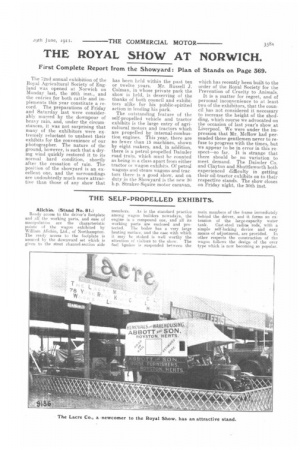
Page 22
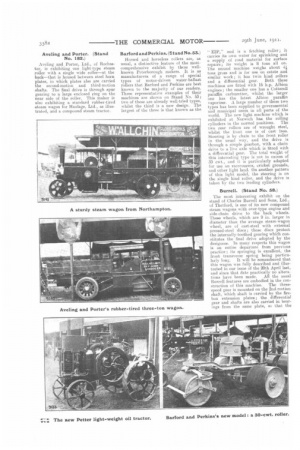
Page 23
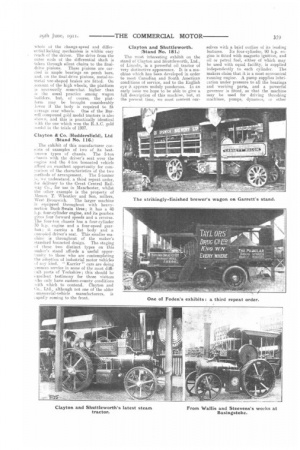
Page 24
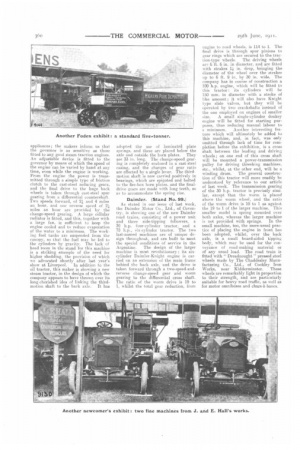
Page 25
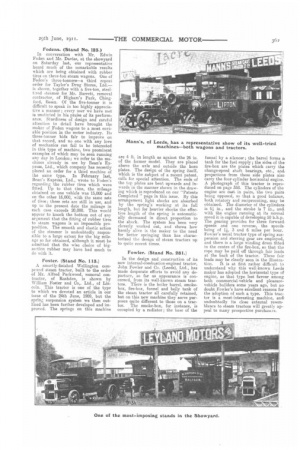
Page 26
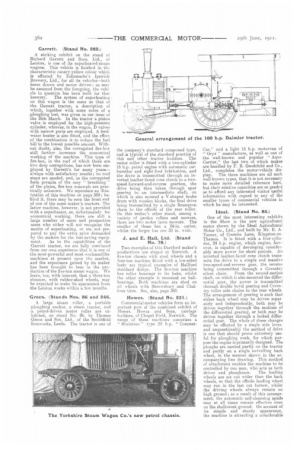
Page 27
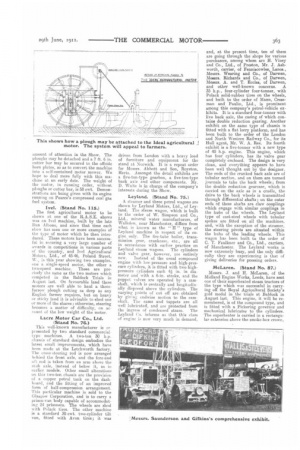
Page 28

Page 29
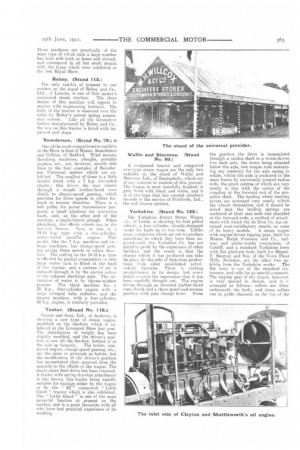
Page 30
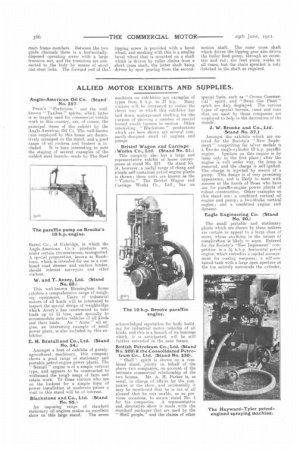
If you've noticed an error in this article please click here to report it so we can fix it.
Allchin. (Stand No. 81.) Ready access to the driver's footplate and all the working parts, and ease of manipulation are the characteristic points id the wagon exhibited by William Allchin, Ltd., of Northampton. The ready access to the foofplate is assured by the downward set which is given to the stout channel-section side members. As is the standard practice among wagon builders nowadays, the engine is a compound one, and all its working parts are enclosed and protected. The boiler has a very large heating surface, and the ease With which it. may he stoked is well worthy the attention of visitorS to the show. The fuel bunker is suspended between the main members of the frame immediately behind the driver, and it forms an extension of the large-capacity water
tank. Cast-steel radius rods, with a simple self-locking device and easy means of adjustment, are provided. In other respects the construction of the wagon follows the design of the over type which is now becoming so popular.
Aveling and Porter. (Stand No. l82.) Aveling and Porter, Ltd., of Rochester, is exhibiting one light-type steam roller with a single wide roller—at the back—that is housed between steel horn plates, in which plates also are carried the second-motion and third-motion shafts. The final drive is through spur gearing to a large enclosed ring on the near side of the roller. This maker is also exhibiting a standard rubber-tired steam wagon for Haulage, Ltd., as illustrated, and a compound steam tractor.
Barford and Perkins.(StandNo.55.,,
Horsed and horseless rollers are, as usual, a distinctive feature of the mostcomprehensive exhibit by these wellknown Peterborough makers. It is as manufacturers of a range of special types of motor-driven water-ballast rollers that Buford and Perkins are best known to the majority of our readers. Three representative examples of their machines are shown on Stand No. 53; two of these are already well-tried types, whilst the third is a new design. The largest of the three is that known as the
" Ea'," and is a fetching roller; it carries its own water for sprinkling and a supply of road materiat for surface repairs; its weight is 8 tuns all on. The second machine weighs about 41 tons gross and is for use on estate and similar work; it has twin hind rollers and a differential gear. Both these maehilas are fitted with 16 h.p. Albion engines; the smaller one has a Cotterell paraffin carburetter, whilst the larger one has the latest Albion paraffin vaporizer. A large number of these two types has been supplied to governmental and municipal users in all parts of the world. The new light machine which is exhibited at Norwich has the rolling cylinders in the normal positions. The two rear rollers are of wrought steel, whilst the front one is of cast iron. Steering is by chain to the front roller in the usual way, and the drive is through a simple gearbox, with a chain drive to a live axle which is fitted with a differential gear. The total weight of this interesting type is not in excess of 30 cwt., and it is particularly adapted for use on racecourses, cricket grounds, and other light land. On another pattern of this light model, the steering is on the single hind roller, and the drive is taken by the two leading cylinders Burrell. (Stand No. 58.)
The most interesting exhibit on the stand of Charles Burrell and Sons, Ltd., of Thetford, is one of its new compound steam wagons with over-type engine and side-chain drive to the 1back wheels. These wheels, which are 9 in. larger in diameter than the average steam-wagon wheel, are of cast-steel with external pressed-steel discs; these discs protect the internally-toothed gearing which constitutes the final drive adopted by the designers. in many respects this wagon is an entire departure from previous practice ; its springing is excellent, the front transverse spring being particularly long. It will be remembered that this wagon was fully described and illustrated in our issue of the 20th April last, and since that date practically no altera tions have been made. All the usual Burrell features are embodied in the construction of this machine. The threespeed gear is mounted on the 2nd-motion shaft, which shaft is carried by the firebox extension plates; the differential gear and shafts are also carried in bearings from the same plate, so that the whole of the change-speed and differential-locking mechanism is within easy reach of the driver. The drive from the outer ends of the differential shaft is taken through silent chains to the final
drive pinions. These pinions are carried in ample bearings on perch bars, and, on the final-drive pinions, metal-tometal Yee-shaped brakes are fitted. On account: of the high wheels, the platform is necessarily somewhat higher than is the usual practice among wagon Imilders, but, of course, the platform may be brought considerably lower if the body is required to fit average rear wheels. One of the Burrell compound gold medal tractors is also shcoN n, and this is practically identical %iti; the one which won the R.A.C. gold medal in the trials of 1907.
Clayton & Co. ‘.Huddersfield), Ltd (Stand No. 116.) The exhibit of this manufacturer consists of examples of two of its bestHlown types of chassis. The 5-ton ,•Uassis with the driver's seat over the engine and the 4-ton bonneted vehicle afford an excellent opportunity for corneArison of the characteristics of the two methods of arrangement. The 5-tonner Is, we understand, a third repeat order, for delivery to the Great Central Railway Co., kr use in Manchester, whilst the other example is the property of Nlesses. T. Wheatley and Son, millers,
West Broniwiele The larger machine is equipped throughout with heavysection Dook-Swain tires; it has a 40 li.p, four-cylinder engine, and its gearbox gives four forward speeds and a reverse. The four-tcm chassis has a four-cylinder 30 li.p, engine and a fonr-sneef gearbox; it carries a fiat body and a eanopied driver's seat. This smaller machine is throughout of the maker's standard bonneted design. The staging of these two distinct types on this maker's stand affords a useful opporunity to those who are contemplating the adoption of industrial motor vehicles 4,1' any kind. " Karrier " cars are doing yeoman service in some of the most difficult parts of Yorkshire; this should be +xcellent testimony for those visitors %silo only have eastern-county conditions with which to contend. Clayton and Co., Ltd:, although not one of the older :ommercial-vehicle manufacturers, is lapidly coming to the front.
Clayton and Shuttleworth. (Stand No. 181.)
The most interesting exhibit on the stand of Clayton and Shuttleworth, Ltd., of Lincoln, is a powerful oil tractor of very distinctive appearance. It is a machine which has been developed in order to meet Canadian and South American conditions of service, and to the English eye it appears unduly ponderous. In an early issue we hope to be able to give a full description of this machine, but, at the present time, we must content our
selves with a brief outline of its leading
features. Its four-cylinder, 90 Lep. engine is fitted with magneto ignition, and oil or petrol fuel, either of which may be used with equal facility, is supplied independently to each cylinder. The makers claim that it is a most economical running engine. A pump supplies lubrication under pressure to all the bearings and working parts, and a powerful governor is fitted, so that the machine may be used for driving threshing machines, pumps, dynamos, or other appliances ; the makers inform us that the governor is as senaitive as those fitted to any good steam traction engines. An adjustable device is fitted to the governor by means of which the speed of the engine can he varied by hand at ally time, even while the, engine is working. From the engine the power is transmitted through a simple type of friction clutch to the cast-steel reducing gears, and the final drive to the huge back wheels is taken through cast-steel spur gearing from a differential countershaft. Two speeds forward, of 21 and 4 miles an hour, and one reverse speed of 21 miles an hour are provided by the change-speed gearing. A large cellular radiator is fitted, and this, together with a large fan, is sufficient. to keep the engine cooled and to reduce evaporation of the water to a minimum. The working fuel tanks are suspended from the canopy. se that the fuel may be fed to the cylinders by gravity. The lack of head mom in the stand for this machine is a striking example of the need for higher shedding, the provision of which we advocated shortly after last year's
show at Liverpool. In addition to the oil tractor, this maker is showing a new steam tractor, in the design of which the company appears to have thrown over its long-cherished idea of linking the thirdmotion shaft to the hack axle. It has adopted the use of laminated plate springs, and these are placed below the axle and outside the horn plates. They are 33 in. long. The change-speed gearing is completely enclosed in a east-steel caging, and the changes of gear ratio are effected by a single lever. The thirdmotion shaft is now carried positively in bearings, which are spigoted and bolted to the fire-box horn plates, and the finaldrive gears are made with long teeth, so as to accommodate the spring rise.
Daimler. (Stand No. 99.)
As stated in our issue of last week, the Daimler Motor Cc., Ltd., of Coventry, is showing one of the new Daimler road trains, consisting of a power unit and three side-tipping followers, a 30 h.p. four-cylinder tractor, and a 75 h.p., six-cylinder tractor. The two last-named machines are of unique design throughout, and are built to meet the special conditions of service in the
Argentine. The design of the larger maehine is most revolutionary ; its sixcylinder Daimler-Knight engine is carried on an extension of the main frame behind the back axle. and the drive is taken forward through a two-speed-andreverse change-speed gear and worm gearing to the differential cross shaft. The ratio of the worm drive is 19 to 1, whilst the total gear reduction, from
engine to road wheels, is 114 to 1. The final drive is through spur pinious to gear rings which are secured to the trac
tion-type wheels. The driving wheels are 6 ft. 6 in. in diameter, and. are fitted with strakes 14 in. deep, bringing the diameter of the wheel over the stra.kes up to 6 ft. 9 in. by 30 in. wide. The company has in course of construction a 100 h.p. engine, which will be fitted to this tractor: its cylinders will be 150 mm. in diameter with a stroke of like amount; it will also have Knight type slide valves, but they will he operated by two crankshafts instead of the one employed on engines of smaller size. A small single-cylinder donkey engine will be fitted for starting purposes, thus reducing manual labour to
a minimum. Another interesting feature which will ultimately be added to this machine, and, in fact, was only omitted through lack of time for completion before the exhibition, is a cross shaft between the leading and driving wheels; on one end of this cross shaft will be mounted a power-transmission pulley for driving threshing machines, etc., whilst, at the other end, will be a winding drum, The general construction of this tractor will more readily be understood by reference to our article of last week. The transmission gearing of the 30 h.p. tractor is precisely similar, except that the worm is placed above the worm wheel, and the ratio of the worm drive is 10 to 1 as against the 19 to I of the larger machine. This smaller model is spring mounted over both axles, whereas the larger machine
is not provided with springs. In the small machine, too, the more-usual practice of placing the engine in front has been adopted, whilst, over the back axle, is a small board-sided tipping body, which may be used for the conveyance of road-making material or of any usual load. The road train is fitted with " Dreadnought" pressed steel wheels made by The Chaddesley Manufacturing Co., Ltd., of Cooleley Iron Works, near Kidderminster. These wheels are remarkably light in proportion to their strength, and are particularly suitable for heavy road traffic, as well as for motor omnibuses and chars-Vbancs.
Fodens. (Stand No. 125.)
In conversation with Mr. Edwin Foden and Mr. Davies, at the showyard on Saturday last, our representative heard much of the remarkable results which are being obtained with rubber tires on three-ton steam wagons. One of Foden's three-tonners—a third repeat order for Taylor's Drug Stores, Ltd.— is shown, together with a five-ton, steelVred steamer for Mr. Barrett, removal contractor, of Higham's Park, Chingford, Essex. Of the five-tonner it is difficult to speak in too highly appreciative a manner ; every user we have met is unstinted in his praise of its perform. ance. Sturdiness of design and careful attention to detail have brought the maker or Foden wagons to a most enviable position in the motor industry. Its three-tonner bids fair to improve on that record, and no one with any love of mechanics can fail to be interested in this type of machine, two prominent examples of which may be seen running any day in London; we refer to the machines already in use by Bean's Express, Ltd., which company has recently placed an order for a third machine of the same type. In February last, Bean's Express, Ltd., wrote to Forlen's regarding the rubber tires which were fitted. Up to that time, the mileage obtained on one vehicle was 15,000 and on the other 16,000; with the same sets of tires ; these sets are still in use, and up to the present date the mileage in each case exceeds 20,000. This would appear to knock the bottom out of any argument that the fitting of rubber tires to steam wagons is an impossible proposition. The smooth and elastic action of the steamer is undoubtedly responsible to a large extent for the big mileage so far obtained, although it must be admitted that the wise choice of bigsection rubber may have had much to do with it.
Foster. (Stand No. 115.)
A smartly-finished Wellington compound steam tractor, built to the order of Mr. Alfred Packwood, removal contractor, of Rushden, is shown by William Foster and Co,. Ltd., of Lincoln. This tractor is one of the type to which we devoted an article in our issue of the 24th June, 1900, but the spring suspension system we then outlined has been further developed and improved. The springs on this machine are 4 ft. in length as against the 26 in. of the former model. They are placed above the axle and outside the horn plates. The design of the spring itself, which is the subject of a recent patent, calls for special attention. The ends of the top plates are bent upwards and inwards in the manner shown in the drawing which is reproduced on our "Patents Completed " page in this issue. By this arrangement light shocks are absorbed by the spring's working at its full length, but for heavier shocks the effective length of the spring is automatically decreased in direct proportion to the shock. The system has been very cleverly worked out, and shows bow keenly alive is the maker to the need for better springing than has characterized the design of steam tractors up to quite recent times.
Fowler. (Stand No. 281.)
In the design and construction of its new internal-combustion-engined tractor, John Fowler and Co. (Leeds), Ltd., has made desperate efforts to avoid any departure, so far as appearance is concerned, from its well-known steam tractors. There is the boiler barrel, smokebox, fire-box, funnel and belly tank of the steam tractor all carefully retained, but on this new machine they serve purposes quite different to those on a tractor. The smoke-box, for instance, is occupied by a radiator; the base of the
funnel by a silencer ; the barrel forms a tank for the fuel supply; the sides of thefire-box are the plates which carry the change-speed shaft bearings, etc., and. projections from these side plates also carry the four-cylinder horizontal engine. A photograph of this tractor is reproduced on page 358. The cylinders of the engine are cast in pairs, the two pairs being opposed, so that a good balance, both rotatory and reciprocating, may be obtained. The diameter of the cylinders is 61 in., and the stroke is 7 in., and with the engine running at its normal speed it is capable of developing 50 b.h.p. The gearing provides for three forward speeds and one reverse, the speedsbeing of 4, 3 and 6 miles per hour. Fowler's usual tractor type of spring suspension and steering gear are employed, and there is a large winding drum fitted in the centre of the fire-box, so that the rope may be paid off through faitleads at the back of the tractor. These fair leads may be clearly seen in the illustra tion. ft is at first rather difficult to understand why this well-known Leeds maker has adopted the horizontal type of engine, as that type lost favour among both commercial-vehicle and pleasure. vehicle builders some years ago, but no doubt Fowler's have excellent reasons for the adoption of such a type. This tractor is a most-interesting machine, and undoubtedly its close external resemblance to steam tractors will greatly appeal to many prospective purchasers. Garrett. (Stand No. 282.)
A striking exhibit on the stand of Richard Garrett and Sons, Ltd., of Leiston, is one of its superheated-steani wagons. This vehicle is finished in the -characteristic canary-yellow colour which is affected by Tollemache's Ipswich Brewery, Ltd., for all its vehicles—both horse drawn and motor driven ; as may be assumed from the foregoing, the vehicle in question has been built for that brewery. The system of superheating on this wagon is the same as that of the Garrett tractor, a description of which, together with some notes of a ploughing test, was given in our issue of the 16th March. In the tractor a piston -valve i8 employed for the high-pressure cylinder, whereas, in the wagon, D valves with narrow ports are employed. A feed. water heater is also fitted, and the effect -of the combination is to reduce the fuel bill to the lowest possible amount. With. out doubt, also, the corrugated fire-box still further increases the economical working of the machine. This type of fire-box, in the roof of which there are two deep corrugations, has now been employed by Garrett's for many years— always with satisfactory results ; no roof stays are needed, and, as the corrugated form permits of the easy breathing " of the plates, fire-box renewals are practically unknown. We reproduce an illustration of this machine on page 359; behind it, there may be seen the front end of one of the same maker's tractors. The latter machine, however, is not provided 'with a superheater, as, unfortunately for economical working, there are still a large number of users and prospective users who either will not recognize the merits of superheating, or are not prepared to pay the extra price demanded by the makers for the fuel-saving equip ment. As to the capabilities of the 'Garrett tractor, we are fully convinced from our own experience that it is one of the most-powerful and most-workmanlike machines at present upon the market, and the experience gained by its maker has been brought to bear Ili the production of the five-ton steam wagon. We learn, too, with interest, that a three-ton steamer, with rubber-shod wheels, may be expected to make its appearance from the Leiston works within a few months.
Green. (Stands Nos. 86 and 246.
A large steam roller, a portable ploughing anchor, a steam tractor, and -a petrol-driven motor roller are exhibited, on stand No. 86, by Thomas Green and Son, Ltd., of the Smithfield Ironworks, Leeds. The tractor is one of the company's standard eumpound type, and is typical of the standard practice of this and other tractor builders. The motor roller is fitted with a two-cylinder 16 h.p. petrol engine with automatic carburetter and sight-feed lubrication, and the drive is transmitted through an inverted leather-faced cone clutch to a twospeed-forward-and-reverse gearbox, the drive being then taken through spur gearing to an intermediate shaft, on which is also secured a V-shaped brake drum with wooden blocks, the final drive being transmitted by a single Brampton chain to the offside of the rear roller. On this maker's other stand, among a variety of garden rollers and mowers, there are two motor lawn mowers. The smaller of these has a 24-in, cutter, whilst the larger ha e one 30 in. wide.
J. and E. Hall, Ltd. (Stand No. 78.)
Two examples of this Dartford maker's productions are staged at Norwich. A five-ton chassis with steel wheels and a four-ton machine fitted with a low-sided body are typical examples of Hallford standard design. The five-ton machine has roller bearings in its hubs, whilst the other example is mounted on ballhearings. Both machines are shod on all wheels with Shrewsbury and dialliner tires. See, also, page 360.
Howes. (Stand No. 231.)
Commercial-motor vehicles form an important part of the combined exhibit of Messrs. Howes and Sons, carriage builders, of Chapel Field, Norwich. The range of these machines comprises a " Braintree " type 22 h.p. " Commer
Car,' and a light 15 h.p, motorvan of " Oryx " manufacture, as well as one of the well-known and popular " AutoCarrier," the last. two of which makes are handled by F. B. Goodchild and Co., Ltd., completes the motor-vehicle display. The three machines are all such well-known types, that it is not necessary to make more detailed reference here, but their relative capacities are so graded as to afford any interested visitor useful information with regard to any of the smaller types of commercial vehicles in which he may be interested.
Ideal. (Stand No. 85.)
One of the most interesting exhibits in the Show is the new agricultural motor shown by the Ideal Agricultural Motor Co., Ltd., and built by Mr. E. A. Turner, of Coombe Lane, Kingston-on Thames. It is fitted with a four-cylin. der, 24 h.p. engine, which engine, however, is capable of developing considerably more power for short periods. An inverted leather-faced cone clutch transmits the drive to a simple and massive two-speed-and-reverse gear, the reverse being transmitted through a Coventry
silent chain. From the second-motion shaft, on which is also mounted the differential gear, the power is transmitted through double bevel gearing and Coventry roller side chains to the rear wheels. The arrangement of gearing is such that either back wheel may be driven separ• ately and independently, both may be driven together through the medium of the differential gearing, or both may be driven together through a locked differential gear. The whole of these changes may be effected by a single side lever, and unquestionably the method of drive 18 one that should prove extremely useful for ploughing work, for which purpose the engine is primarily designed. The ploughs are carried partly on the tractor and partly on a single swivelling back wheel, in the manner shown in the accompanying line drawing. This method of attachment enables the machine to be controlled by one man, who acts as both
driver and ploughman. The leading wheels are set out wider than the back wheels, so that the offside leading wheel may run in the last cut furrow, whilst the driving wheels always remain on high ground; as a result of this arrangement, the automatic self-cleansing spuds may at all times remain effective even on the shallowest ground. On account of its simple and sturdy appearance, the machine is attracting a considerable
amount of attention in the Show. The ploughs may be detached and a 7 ft. 6 in. cutter bar may be secured to the offside horn plates, so as to convert the machine into a self-contained motor mower. We hope to deal more fully with this machine at an early date. The weight of the motor, in running order, without ploughs or cutter bar, is 58 cwt. Demonstrations are being given with its engine running on Pearce's compressed coal gas fuel system.
Ivel. (Stand No. 115.)
The first agricultural motor to be shown at one of the R.A.S.E. shows was an Ivel machine, built by the late Dan Albone, and since that time each show has seen one or more examples of the type of motor which he then introduced. These motors have been successful in securing a very large number of awards in competitions in various parts of the country, and Ivel Agricultural Motors, Ltd., of 45-46, Poland Street, W., is this year showing two examples, one a single-speed motor, the other a two-speed machine. These are precisely the same as the two motors which competed in the Baldock Trials in August last. On favourable land these motors are well able to haul a threefurrow plough cutting as deep as any English farmer requires, but on heavy or sticky land it is advisable to shed one or more of the shares; otherwise, steering becomes a matter of difficulty, on account of the low weight of the motor.
Lacre Motor Car Co., Ltd. (Stand No. 76.) This well-known manufacturer is represented by two standard commercialtype machines. A two-ton 30 h.p. chassis of standard design embodies the latest small improvements, which have been made at the Letchworth factory. The cross steering rod is now arranged behind the front axle, and the fore-and aft rod is taken from an arm above the stub axle instead of below it, as in earlier models. Other small alterations on this two-ton, chassis are the provision of a copper petrol tank on the dashboard, and the fitting of an improved form of half-compression arrangement. This particular machine is sold to the Glasgow Corporation and is to carry a prison-van body capable of accommodating 24 prisoners. The wheels are shod with Polack tires. The other machine is a standard 30-cwt. two-cylinder tilt van, fitted with Avon tires; it was
driven from London with a heavy load of furniture and equipment for the stand at Norwich. It is a repeat order for Messrs. Abbott and Son, Royston, Herts. Amongst tho detail exhibits are a five-ton-type gearbox, a five-ton-type back axle and other components. Mr. D. Waite is in charge of the company's interests during the Show.
Leyland. (Stand No. 75.) A. steamer and three petrol wagons are shown by Leyland Motors, Ltd., of Leyland. The steam wagon, which is built to the order of W. Simpson and Co., Ltd., mineral water manufacturers, of Walkden, near Manchester, differs from what is known as the " II " type of Leyland machine in respect of its engine only. The fire-tube boiler, transmission gear, crankcase, etc., are all in accordance with earlier practice on Leyland steam wagons. The cylinders and valve gear, however, are entirely new. Instead of the usual compound engine with low-pressure and high-pressure cylinders, it is fitted with two highpressure cylinders each 41 in. in diameter and with a 6-in, stroke, and the poppet valves are operated by a camshaft, which is centrally and longitudinally disposed above the cylinders. The varying points of cut off are. obtained by giving endwise motion to the camshaft. The cams and tappets are all well lubricated, and are protected from the ingress of condensed steam. The Leyland Co. informs us that this class of engine is now very much in demand,
and, at the present time, ten of them are going through the shops for various purchasers, among whom are H. Viney and Co., Ltd., of Preston, Mr. J. Ashworth, carrier, of Fenniscowles, Lancs., Messrs. Wearing and Co., of Darwen, Messrs. Richards and Co., of Darwen, Messrs. A. and T. Eccles, of Darwen, and other well-known concerns. A 35 h.p., four-cylinder four-tonner, with Polack solid-rubber tires on the wheels, and built to the order of Mann, Crossman and Paulin, Ltd., is prominent among this company's petrol-vehicle exhibits. It is a standard four-tonner with live back axle, the casing of which contains double reduction gearing. Another exhibit on the same type of chassis is fitted with a flat lorry platform, and has been built to the order of the London and North Western Railway Co., for its Huil agent, Mr. W. A. Rec. Its fourth exhibit is a five-tonner with a new type of 40 h.p. engine. This engine, which has four cylinders, has its valve gear completely enclosed. The design is very clean, and everything appears to have been well thought out by the designer. The ends of the cranked back axle are of tubular section, and on them are turned journals to take the back wheels ; from the double reduction gearcase, which is carried on the axle as in a cradle, the drive to the back wheels is transmitted through differential shafts; on the outer ends of these shafts are claw couplings which engage with similar couplings in the hubs of the wheels. The Leyland type of cast-steel wheels with tubular spokes are fitted on all the machines, and, with the exception of the steamer, the steering pivots are situated within the hubs of the leading wheels. This wagon has been built to the order of C. T. Faulkner and Co., Ltd., carriers, of Manchester. The Leyland works is now extremely busy, and the only difficulty they are experiencing is that of giving deliveries for pressing orders.
McLaren. (Stand No. 87.)
Messrs. J. and H. McLaren, of the Midland Engine Works, Leeds, have sent one of their superheated steam tractors of the type which was successful in carrying off the Royal Agricultural Society -'8 gold medal in the trials at Baldoek in August last. This engine, it will be remembered, is of the compound type, and is fitted with a Pickering governor and mechanical lubricator to the cylinders. The superheater is carried in a rectangular extension above the smoke-box crown,
and it consists of four coils of soliddrawn-steel tubing. A feed-water heater is also fitted. It is interesting to note how the method of spring mounting the front axle in this machine differs from the regular practice of other makers; the laminated semi-helical plate spring is inverted, the centre being firmly bolted to the steering pivot pin, while the ends are shackled to brackets which are secured to the bottom of the fire-box shell.
. Mann's. (Stand No. 77.)
Four machines constitute the exhibit of Mann's Patent Steam Cart and Wagon Co., Ltd., of Pepper Road Works, launslet, Leeds. This company's new type of steam tractor, a brief outline of which was given in our forecast of the exhibits last week, is given a prominent place upon the stand. This machine has a particularly narrow main frame, and has two very wide rear wheels, each of which is made up of two parts: a permanent stroped wheel 16 in. wide, and an extension ring 5 in. wide. In other respects this tractor is almost identical with the one which competed in the R.A.S.E. Trials at Bahia& in August last. Its engine is a twin-cylinder compound with Pickering governor. Inverted laminated springs are provided for the back axle, and this axle is ballasted by the large water tank which partly encircles the rear wheels. One of Mann's patent tipping carts with gear transmission throughout is also shown. This has been built to the order of Mr. Alban Richards, contractor, of Pentre, Glamorgan. An entire departure from Mann's previous practice in the construction of five-ton steam wagons is a machine which has been built for Liptons, Ltd., and is now shown; this is the first time that one of Mann's over-type wagons has been exhibited. It has a two-speed-andreverse gear with a final drive through a single 20n. pitch roller chain, and is further evidence of the increasing demand for over-type wagons. It must not be assumed, however, that this maker has thrown over the idea of under-type engines running in an oil bath and with all-gear drive to the back axle, as it still manufactures that type and will continue to do so. The company's belief in it is unshaken by the prevailing fashion for over-type machines; an engine and gearing of which all the working parts are enclosed in an oil bath is certainly to be preferred for many purposes, although the greater degree of accessibility which
the over-type provides is a strong argument in favour of the latter type. A patching roller is also exhibited, This particular machine has been buiit, for the Shanghai Corporation.
Marshall. (Stand No. 110.)
Two examples of Marshall's Colonialtype oil tractors are shown by Marshall, Sons and Co., Ltd., of Gainsborough, both machines being of impressive construction. One of these has a two-cylinder engine with cylinders of 7 in. in diameter with a stroke of similar dimension; the other machine is of like build, but it has four cylinders of the same size. One's first impression of these machines is that they are ungainly monsters, but it must be remembered that they are constructed to meet the special requirements of such countries as Canada, the Argentine, etc., where they are employed for big-scale ploughing. The maker's special department for these tractors is kept busy for 24 hems each day in coping with current orders. In both the machines shown the drive is transmitted through massive cast-steel spur gearing, the final drive being from half-shrouded steel pinions to cast-steel rings with external teeth. Cast integral with these rings are radial arms which are bolted to one of the flanges of the traction-type steel wheels; the drive is thus transmitted direct to the rims of the wheels, and it relieves the spokes of all torsional strain. Both engines are water-cooled, and the cooling water is carried in a largo tank at the forward end of the tractor; it is circulated by pump, the delivery from the top of the cylinders being to a distributing pipe, from which the water trickles down a series of cooling plates. A current of air is induced to pass along and through these cooling plates by the ejector action of the exhaust nozzle. The diameter of the roar wheels is 6 ft.. 3 in., and the width 24 in., whilst, the width of the wheels on the smaller ones is 18 in. The leading -wheels are 4 ft. 6 in, in diameter by 12 in. wide for the four-cylinder ma, chine and 9 in. wide for the two-cylinder machine.
Petters. (Stand No. 22.) '•
An entirely new model from Petters, Ltd., of Yeovil, is a 20 h.p. oil tractor, the gross weight of which is three tons. It is driven by a single-cylinder, twocycle. oil oil engine, capable of giving 20 b.h.p. On the one end of the crankehaft is a large flywheel, and at the other end is the internal member of a friction clutch. The outer member of this clutch serves a ',sal purpose : as a brake drum, or, when the brake band is removed, as a power-transmission pulley for driving machinery. The power is transmitted from the clutch shaft to a differential shaft through the medium of a single roller chain, and from the ends of the differential shaft the final drive is transmitted through spur gearing. It is quite a new departure from Petter's previous practice, as all their older models had single-cylinder horizontal slow-speed engines. The vertical engine fitted to the new light tractor, however, is by no means in its experimental stages, as the works have for some considerable time been busily engaged in the production of engines of this type for general powertransmission purposes, and, as evidence of the steady running of these machines, we need only inform our readers that many of these engines are now in use for driving various electric-lighting machinery and cinematograph outfits, for which purpose absolutely steady running is imperative.
Ransomes. (Stands Nos. 43 and 288.)
Stand No. 48 is occupied chiefly by traction engines, threshing machines, rakes, tedders, etc., exhibited by Raneomes, Sims and Jefferies, Ltd., of the Orwell Works, Ipswich, but one of that maker's 4 h.p. nominal steam tractors is also included. The company has been building this type for some years past. It has a compound engine, two-speed gear, winding drum, and all the usual accessories which have been found necessary during the firm's many years' experience in the building of road locomotives. An extra tank is also fitted, so as to increase the range of action of the machine. It is capable of hauling loads of from five to eight tons, according to the conditions of the road. The machine shown at Norwich is provided with a Pickering governor, and its price, complete with awning and necessary tools, is £805. This eompany has a second stand (No. 288), on which are exhibited, amongst a large range of mowers of all types, three engine-driven examples: a two-cylinder, 42-in, machine fitted with a driver's seat; a single-cylinder, water-cooled, handle operated machine; and a third machine which is fitted with a 2i h.p. 'air-coaled engine.
These machines are practically of the same type of which such a large number has been sold both at home and abroad. and correspond in all but small details with the types which were exhibited at the last Royal Show.
Robey. (Stand 112.)
The only exhibit of interest to our readers on the stand of Robey and Co., Ltd.. of Lincoln, is one of that maker's compeund steam tractors. The clean desig.ii of this machine will appeal to anyone with engineering instincts. The body of the tractor is mounted over the axles by Robey's patent spring suspen sion eystem. Like all the locomotive boilers manufactured by Robey and Co., the one on this tractor is fitted with improved roof stays.
Saunderson. (Stand No. 79.)
One of the most-comprehensive exhibits in the Show is that of Messrs. Saunderson and Gifkins, of Bedford. Wind motors, threshing machines, ploughs, portable engines, etc., are, however, merely side lines to the four examples of Sauederson Universal motors which are exhibited. The smallest of these is a little tractor fitted with a 7 h.p. air-cooled engine ; this drives the rear wheels through a simple leather-faced cone clutch to change-speed gearing, which provides for three speeds in either forward or reverse direction. There is a belt pulley for power transmission purposes, a small platform for conveying loads, and, at the after end of the machine, a single-furrow plough. When ploug-hing, the offside wheels run in the lasta-mt furrow. Next in size is a 14-16 h.p. type with a two-cylinder: water cooled paraffin engine. This model, like the 7 li.p, machine and tw.r large machines, has change-speed gearing giving three speeds in either dimthan. The cooling on the 14-16 lip. type is effected by partial evaporation ; a very large water tank is fitted at the back of the tractor, and a current of ;lir is induced through it by the ejector actien of the exhaust discharge pipe. The cir(Maim of water is by therrno-syphon process. The third machine has a 30 h.p., four-cylinder engine with a large crimped tube radiator, and -the largest machine, with a four-cylinder, 50 h.p, engine, is similarly provided.
Tacker. (Stand No. 119.)
Tasker and Sons, Ltd., of Andover, is showing a now type of steam wagon, modelled on the machine which it exhibited at the Liverpool Show last year. The distribution in weight has been slightly modified, and the driver's position is now aft the fire-box, instead of at
the side aa formerly. The boiler, compound engine, change-speed gearing, etc., are the same in principle as before, but the modification of the driver's position has necessitated their removal from the nearside to the offside of the wagon. The single-chain final drive has been retained. A trailer with spring drawbar attachment is also shown, this trailer being equally snitable for haulage either by the wagon or by the " 52 " compound "Little Giant " tractor which is also exhibited. The " Little Giant " is one of the most powerful tractors at present on the market, and is a great favourite with all who have had practical experience of its working.
Wallis and Steevens. (Stand No. 80.)
A compound tractor and compound over type steam wagon are the only two exhibits on the stand of Wallis and Steven, LW., of Basingstoke, which are of any interest to readers of this journal. The wagon is most tastefully finished in grey lined with black and white, and it is of the type that has created excellent records in the service of Pickfords, Ltd., the well-known carriers.
Yorkshire. (Stand No. 122.)
The Yorkshire Patent Steam Wagon .")o.. of Leeds, is showing its first petrol vehicle, a four-cylinder, cleanly-designed model for loads up to two tons. Unlike many companies which set, out, to produce something to which they have been unaccestomed, the Yorkshire Co. has not failed to profit by the experience of other builders, and the result is that the chassis which it has produced can take its place by the side of first-class productions from older established petrolvehicle factories. There is nothing revolutionary in its design, but every detail rienve.vs the impression that it has been carefully thought out. The engine drives through an inverted leather-faced cone clutch and a three-speed-and-reverse genrhox with gate change lever. From the gearbox the drive is transmitted through a cardan shaft to a worm-driven live back axle, the worm being situated below the axle, two torque rods restraining any tendency for the axle easing to rotate, whilst the axle is anchored to the main frame by universally-jointed radius rods, the pivot centres of which are very nearly in line with the -centre of the coupling at the forward end of the propeller shaft. The leading wheel steering pivots are arranged very nearly within the wheels themselves, and it should be noted that the leading springs are anchored at their rear ends and shackled at the forward ends, a method of attachment with which the de Dion Co, has obtained most-satisfactory results on some of its heavy models. A steam wagon with engine-driven tipping gear, built for Messrs. Ralph Pomeroy and Co., railway and public-works contractors, of Cardiff, and a standard Yorkshire lorry with flat platform body built for Messrs. F. Skurray and Son, of the Town Flour Mills, Swindon, are the other two exhillite from the Yorkshire works. The fiat lorry is one of the standard sixtot-liters, and calls for no special comment. The tipping gear of the wagon, however. is very special in design, and it ir arranged as follows: rollers are lithei. underneath the body, and these rollers run in guide channels on the top of the
main frame members. Between the two guide channels there is a horizontallydisposed operating screw with a large trunnion nut, and the trunnions are connected to the body by means of stout cast-steel links. The forward end of the tipping screw is provided with a bevel wheel, and meshing with this is a smaller bevel wheel that is mounted on a shaft which is driven by roller chains from a short cross shaft, the latter shaft being driven by spur gearing from the second motion shaft. The same cross shaft which drives the tipping gear also drives the boiler feed pump, through an eccentric and rod; the feed pump works at all times, but the chain sprocket is only clutched to the shaft as required.






































